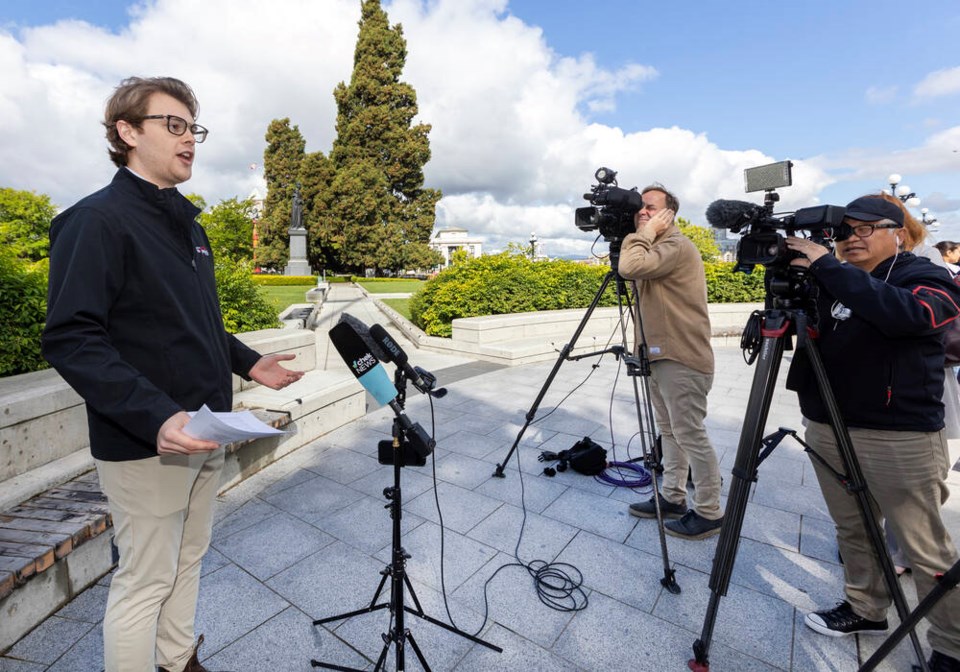Parks Canada will spend about $12 million on a plan to kill invasive deer and restore native vegetation on Sidney Island, according to documents obtained by the Canadian Taxpayers Federation.
That’s more than double the cost that has been widely reported for the controversial project on the small Gulf Island.
“It’s appalling that Parks Canada blew $12 million on a project that local hunters have been doing for free,” the federation’s B.C. director, Carson Binda, said on Wednesday at a news conference in front of the B.C. legislature.
“Our taxpayer dollars shouldn’t be spent on Parks Canada … playing Rambo.”
Parks Canada’s forecast spending of $11.988 million on the restoration of Sidney Island is spread over eight years, according to its Fur to Forest budget, which was obtained by the taxpayers federation through an access-to-information request.
It details costs between 2018 and 2026 that include $2.8 million in salaries and benefits to Parks Canada staff, $1.5 million in studies, $800,000 for Indigenous participation, $3.3 million in miscellaneous expenses — including $53,000 for forest restoration services and plants and trees — and $4.1 million in deer-eradication services.
The initial phase of the deer-kill plan over 11 days in December saw U.S.- and New Zealand-based sharpshooters kill fallow deer from a helicopter during the day and on the ground at night.
But only 84 deer were killed — a toll that included 18 native black tail deer and three that couldn’t be identified.
Parks Canada did not do a detailed census of the fallow deer on Sidney Island before the kill and has relied on a wide estimate of between 300 and 900 fallow deer, though critics of the plan and some resident hunters say the number is closer to 200.
Mass roundups and kills by hunting groups over the past decades have winnowed the fallow-deer population down from thousands at its height.
The first phase of killing in December cost $800,000, including $67,000 to lease a helicopter and $137,000 on firearms certification for international workers to use restricted weapons, according to the documents.
Binda said that was a hit to taxpayers of $10,000 a deer. Meanwhile, he said, residents of Sidney Island who organize annual hunts every fall managed to kill 54 fallow deer in October and November “at no cost to taxpayers.”
“Parks Canada shouldn’t be flying in foreign snipers to shoot deer from a helicopter,” said Binda, adding Parks has “dreamed up the most expensive way imaginable to cull these deer.”
“Local hunters who have been managing the deer for free are obviously a better option for this cull.”
The Canadian Taxpayers Federation is calling on Parks Canada to stop the deer-eradication program as it goes into a second phase this fall and winter.
Parks Canada has said temporary fencing will create enclosed zones of 40 to 120 hectares across Sidney Island and professional ground-based marksmen will kill the remaining deer.
Parks Canada did not immediately respond to a request for an interview, but a spokeswoman said the agency was preparing a statement for release later Wednesday or on Thursday.
Property owners on the nine-square-kilometre Sidney Island — located east of Sidney and just four kilometres from Island View Beach in Saanich — have been divided over the Parks Canada plan to kill the fallow deer.
Parks Canada controls about 440 hectares on the north end of Sidney Island, including Sidney Spit, as part of Gulf Islands National Park Reserve. But the majority of the island is privately owned in strata lots and a common area.
Last year, residents approved Parks Canada’s plan for deer eradication in a narrow 52 per cent vote, which gave Parks Canada the green light for the kill.







